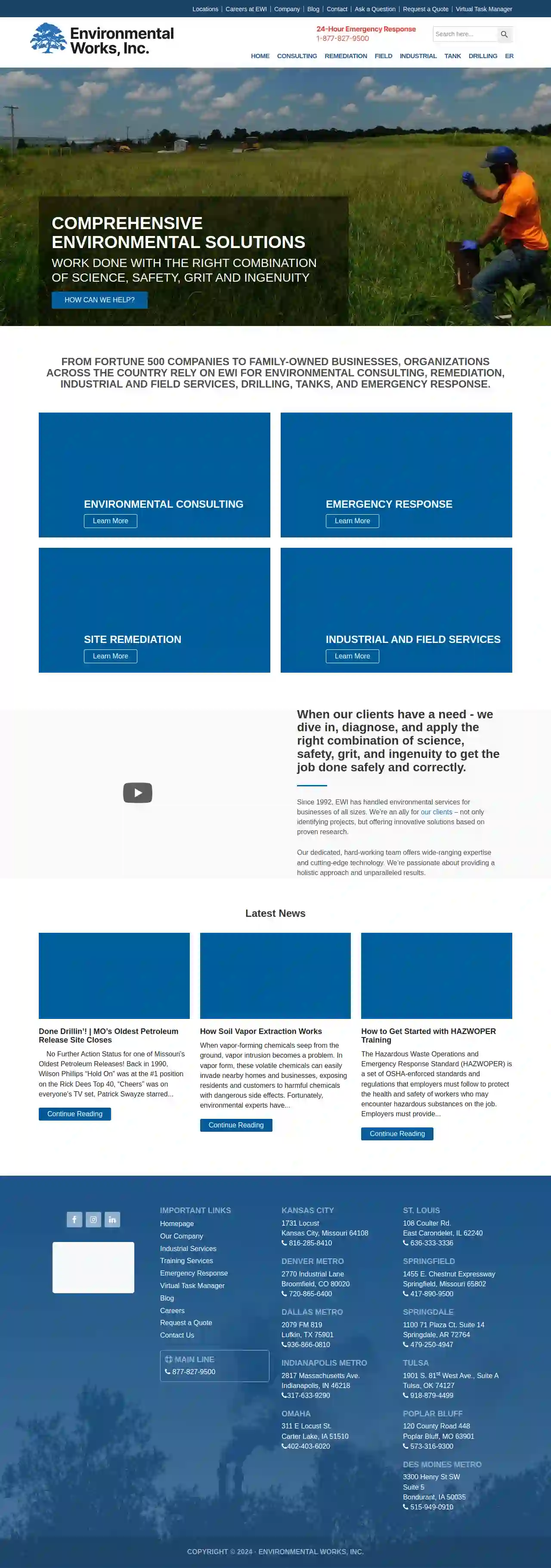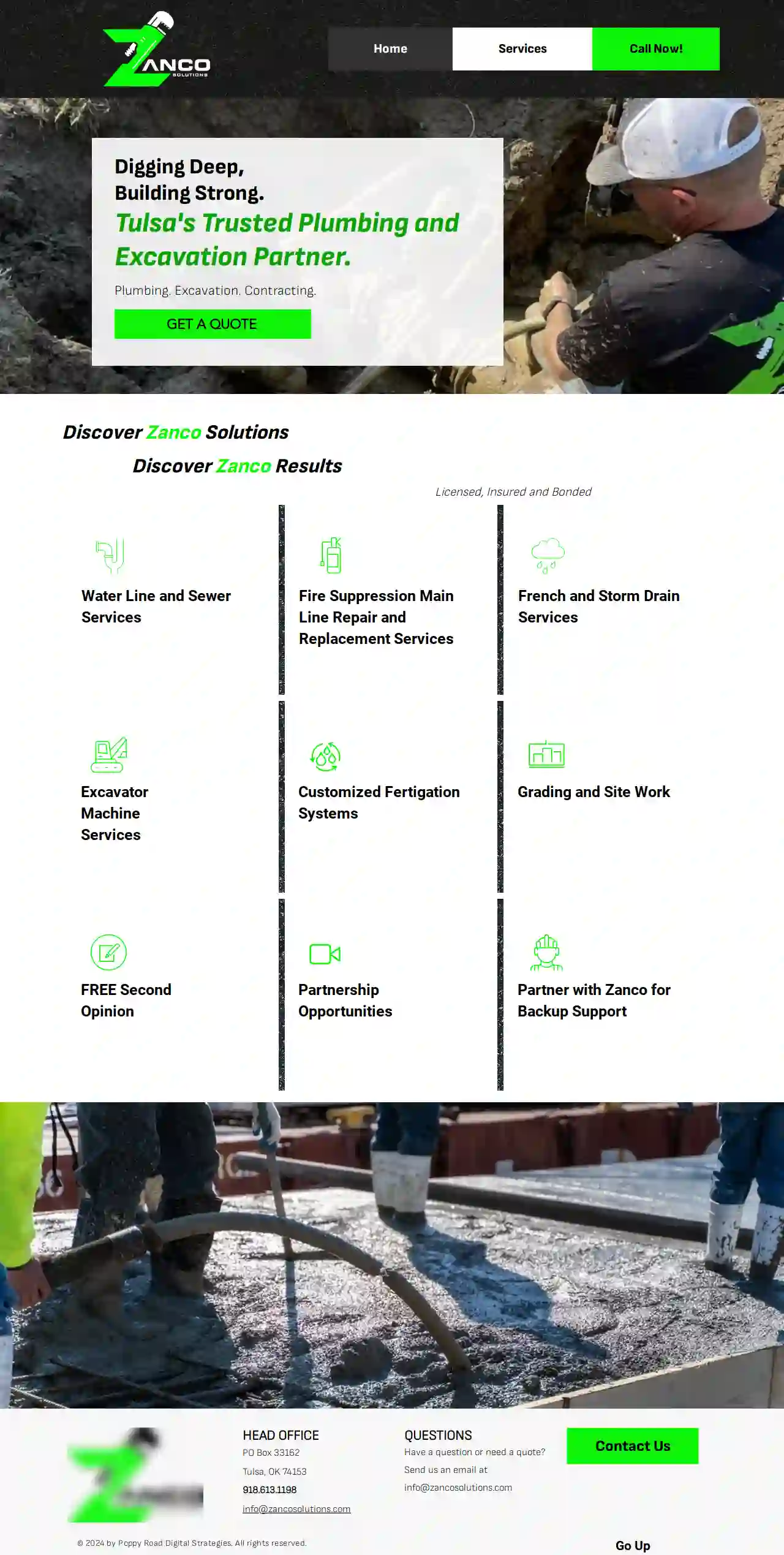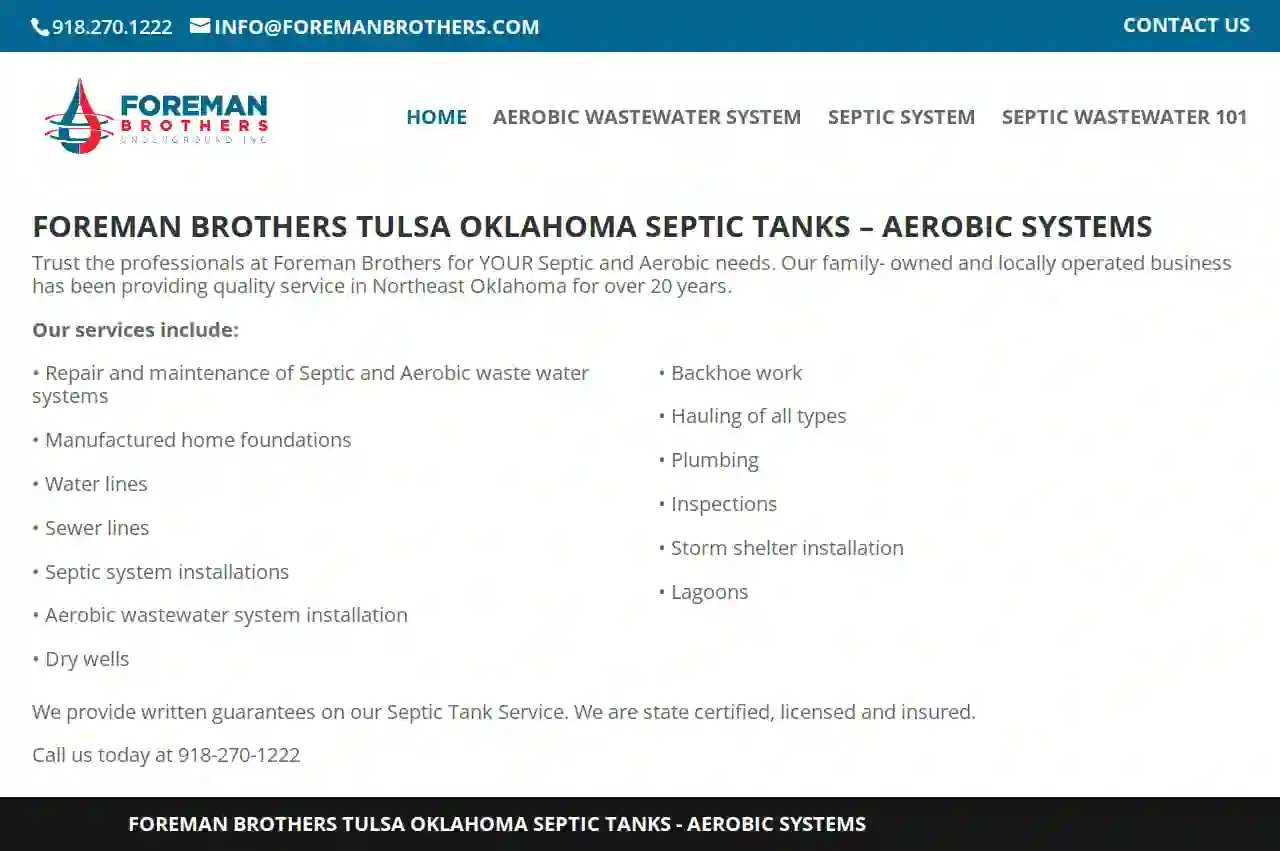Excavation Contractors McAlester
Top 10 Excavation Services in McAlester
Receive multiple Excavation Contractor quotes for your project today! Compare profiles, reviews, accreditations, portfolio, etc... and choose the best offer.

Environmental Works
3.17 reviews1000 N. 10th Street, St. Louis, USEnvironmental Works, Inc. Comprehensive Environmental Solutions Work done with the right combination of science, safety, grit and ingenuity From Fortune 500 companies to family-owned businesses, organizations across the country rely on EWI for environmental consulting, remediation, industrial and field services, drilling, tanks, and emergency response.
- Services
- Why Us?
- Accreditations
- Gallery
Get Quote
Iron Kross Dirt Work Designs
4.110 reviewsTulsa, USIron Kross Dirtwork Designs: Your Trusted Excavation Partner in Tulsa and Beyond Iron Kross Dirtwork Designs is a family-owned business with over 18 years of experience in providing top-notch excavation services for both residential and commercial projects in Tulsa and surrounding areas. We are fully licensed, bonded, and insured, ensuring peace of mind for our clients. Our commitment to quality, professionalism, and customer satisfaction sets us apart. We specialize in a wide range of excavation services, including: Dirtwork Demolition Sewer repair Water and sewer line replacement Land clearing Tree clearing And much more! Our team of experienced and skilled technicians is dedicated to delivering exceptional results on every project. We utilize cutting-edge technology and state-of-the-art equipment to ensure minimal damage and efficient completion. We are committed to clear communication throughout the project, keeping you informed every step of the way. Whether you need a simple landscaping project or a large-scale commercial excavation, Iron Kross Dirtwork Designs is your trusted partner. We are available 24/7 for emergency services, ensuring prompt and reliable assistance when you need it most. Contact us today for a free quote and let us help you bring your vision to life!
- Services
- Why Us?
- Gallery
Get Quote
Earth Smart Construction
4.220 reviewsPO Box 1911, Catoosa, 74015, USBuilding Trust with Quality Work Earth Smart Construction specializes in wet or dry drainage projects from silt removal to grading for proper drainage, as well as many other services listed on our services page. Earth Smart Construction works as part of a collaborative team with our clients to plan and construct each of their projects. Experience has given Earth Smart the proficiency to meet the new challenges of each project. Regardless of the size or span of the project, safety is an active component of quality construction. Earth Smart is committed to performing work in the safest means possible, every day, on every job. The environment is also very important to us here at Earth Smart, where we strive everyday to improve our "green" knowledge. Earth Smart Construction will continue our drive toward "green" certification, and apply it to every project.
- Services
- Why Us?
- Gallery
Get Quote
Appalachian Excavating & Grading LLC
510 reviews1233 N Catawba Church Ave, 1233 North Catawba Church Ave., Lenoir, 28645, USAppalachian Excavating & Grading LLC Appalachian Excavating and Grading LLC is a family-owned business located in Western North Carolina. We are committed to honesty, integrity, and hard work, which are integrated into every project we undertake. Our customer-driven approach ensures that customer satisfaction is our top priority. With a wide range of services and competitive prices, we can fulfill all your grading and excavating needs. We provide excavating and grading services in the greater Western North Carolina area. Our team is equipped with superior equipment and skilled operators to ensure every project is completed to the highest standards. We are cost-conscious for our customers and committed to excellence. By offering a wide range of services and competitive prices, we can eliminate the need for multiple contractors on-site. Contact us today to learn more about our services and to schedule a consultation. We are here to help you achieve your vision for your property!
- Services
- Why Us?
- Gallery
Get Quote
Western Specialty Contractors
4.414 reviewsTulsa, USAbout Western Western Specialty Contractors was founded in St. Louis, MO in 1915 and since then has grown across the United States. The Tulsa area office has served customers throughout Oklahoma since 1949 – a local contractor specializing in waterproofing, concrete and facade restoration. In 2015, Western celebrated our centennial and rebranded as Western Specialty Contractors to provide a more encompassing portrayal of our services. Our Mission We exist to provide effective services that protect, restore, and maintain buildings and structures throughout the United States. Since 1915, Western has stood by its dedication to quality craftsmanship. Today, with 30+ offices across the country, we pride ourselves on being master craftsmen in building envelope repair, specializing in facades, concrete, roofing, and waterproofing. Who We Serve We help property managers, building owners, general contractors, architects, engineers, and consultants across various markets. Why do they trust Western with their projects? We’ve done this work for over a century, and we’ve learned a thing or two along the way. But that’s not the only reason. Western’s qualifications include our robust safety program, strong financial commitment, and fierce quality control program. Get in Touch If you’d like us to look at minor leak issues, provide a proposal for full capital restoration projects, or give an educational presentation to help you and your team make your exterior maintenance more cost-effective, we’d love to connect with you. You can contact us anytime here. Or, if you’re not quite ready for one of those options, we recommend checking out our free resource library full of guides, checklists, and resources.
- Services
- Why Us?
- Testimonials
- Gallery
Get Quote
Zanco Solutions
535 reviewsPO Box 33162, Tulsa, 74153, USDiscover Zanco Solutions Discover Zanco Results Digging Deep, Building Strong. Tulsa's Trusted Plumbing and Excavation Partner. Plumbing. Excavation. Contracting.
- Services
- Why Us?
- Gallery
Get Quote
Fine Excavation
2777 W 173rd St. N, Skiatook, 74070, USAbout Us Fine Excavation was founded in June 2014 with a single CAT backhoe and a half-ton pickup truck. Our goal was to provide Skiatook and the surrounding communities with excellent service and an honest price. Today, nine years later, we have grown to a fleet of several CAT excavators, a CAT skidsteer, hydraulic hammer hoe, and another CAT backhoe. We are proud to say that we are still going strong, and we are committed to providing our customers with the same high-quality service that we did when we first started. We are a family-owned and operated business, and we take pride in our work. We are insured and bonded, and we are always willing to go the extra mile to make sure our customers are satisfied. Whether you are a homeowner, a business owner, or a government agency, we can help you with all of your excavation needs. We offer a wide range of services, including:
- Services
- Why Us?
- Our Team
- Gallery
Get Quote
Midwest Retaining Walls Inc.
49 reviewsTulsa, USAbout Midwest Retaining Walls Inc. Imagine stepping into your backyard and finding it transformed into a beautifully crafted landscape, perfectly tailored to enhance the enjoyment of your property. Welcome to Midwest Retaining Walls Inc, a licensed and insured contractor with over 25 years of expertise in building retaining walls. Family-owned and locally operated in Tulsa, OK, we take immense pride in transforming your outdoor space into a stunning scene. While we build walls, we craft the foundations for your dreams. At Midwest Retaining Walls Inc, we specialize in a variety of services that cater to our residential and commercial customers. Whether you're looking to enhance the utility of your space with a strategically placed retaining wall or you dream of a tranquil backyard oasis complete with a custom-designed koi pond, our team is equipped to make it happen. Our services include detailed excavation and effective drainage solutions, ensuring that every project delivers your vision and more. Our dedication to quality workmanship and exceptional customer service forms the cornerstone of our business philosophy. We believe in maintaining the highest level of professionalism in every project we complete. This commitment is evident in our comprehensive 10-year warranty on all installations and the attractive 30% discount we offer for referrals. Choosing us means investing in a service that values longevity and satisfaction. What sets us apart is our unique capability to deliver free-standing retaining walls and beautifully designed and installed koi ponds that serve as the centerpiece of any garden. Each project is approached with an eye for striking detail. Discover the distinct quality of Midwest Retaining Walls Inc in Tulsa, OK. Allow us to turn your dreams into reality and preserve the beauty of your environment. Reach out today for a complimentary estimate, and begin the journey to realize your vision. Our Services For expert retaining wall installation in Tulsa, OK, call Midwest Retaining Walls Inc at (918) 803-0053. Our experienced team specializes in crafting an outdoor experience complete with koi ponds, drainage and more! Retaining Wall Supplier Excavation Services Drainage Services Koi Ponds Builder Koi Ponds Design Koi Ponds Install Free Standing Retaining Walls
- Services
- Why Us?
- Gallery
Get Quote
Foreman Brothers Underground
32 reviewsTulsa, USForeman Brothers: Your Trusted Septic and Aerobic Experts in Northeast Oklahoma Foreman Brothers is a family-owned and locally operated business with over 20 years of experience serving the Northeast Oklahoma area. We are dedicated to providing high-quality service for all your septic and aerobic wastewater system needs. Our team of experienced professionals is committed to delivering reliable and efficient solutions, ensuring your peace of mind. We understand the importance of a properly functioning septic system, and we are here to help you maintain it. We offer a wide range of services, including: Repair and maintenance of Septic and Aerobic waste water systems Manufactured home foundations Water lines Sewer lines Septic system installations Aerobic wastewater system installation Dry wells Backhoe work Hauling of all types Plumbing Inspections Storm shelter installation Lagoons We are proud to provide written guarantees on our Septic Tank Service, and we are state certified, licensed, and insured. Contact us today for a free consultation and let us help you with all your septic and aerobic needs.
- Services
- Why Us?
- Gallery
Get Quote
United Locating Services - Tulsa
15 reviewsSuite 202, 3819 Stephens Ave., Missoula, 59801, USUnited Locating Services is an industry leader in underground utility locating and damage prevention services. Headquartered in the beautiful city of Missoula Montana, ULS has operations across multiple states. Our highly skilled and professional labor force is always ready to meet the needs of our customers. United Locating Services’ ongoing training and education programs, along with our experienced and highly skilled Quality Control team members ensure that industry standards are met and customer expectations are exceeded. United Locating currently contracts with utility companies to provide damage prevention and locating services in Minnesota, Montana, South Dakota and Texas, and are capable of working anywhere in the United States. If you are interested in using our services for your firm, please call us for more information at 406-541-9571. Whether you’re a local or national business, contractor or homeowner, we would love to hear from you. Feel free to reach out to us with any of your questions.
- Services
- Why Us?
- Gallery
Get Quote
Over 22,076+ Excavation Businesses registered
Our excavation experts operate in McAlester and beyond!
ExcavationHQ has curated and vetted the Best Excavation Pros in and around McAlester. Find the most reliable business today.
Frequently Asked Questions About Excavation Contractors
- Experience: Choose contractors with a proven track record and years of experience in excavation projects similar to yours.
- Licensing and Insurance: Verify that they are properly licensed to operate in your area and carry adequate insurance to protect you from liability in case of accidents or damage.
- Equipment and Resources: Ensure they have the necessary equipment and resources to handle your project efficiently and safely.
- Positive Reviews and References: Check online reviews and testimonials from previous customers. Request references and contact them to inquire about their experience with the contractor.
- Professionalism: Opt for a company that communicates clearly, provides detailed and transparent estimates, and has a responsive and courteous team.
- Spring and Fall: Often considered favorable due to moderate temperatures and drier soil conditions.
- Summer: Can be suitable, but hot weather can make working conditions challenging and might require additional measures (shade, hydration) for workers.
- Winter: Excavation in winter can be more difficult due to frozen ground, snow, and potential delays caused by inclement weather. It might also require specialized equipment or techniques.
- New Construction: Laying foundations, basements, or underground utilities for new buildings.
- Home Additions: Creating space for new rooms, basements, or extensions.
- Landscaping: Leveling ground, creating slopes, installing retaining walls, or digging for ponds or pools.
- Drainage Improvement: Installing French drains, drainage ditches, or swales to manage water runoff.
- Utility Installation or Repair: Laying new water, sewer, gas, or electrical lines, or repairing existing ones.
- Demolition: Clearing debris and preparing the site after demolishing a structure.
How do I find a good excavation contractor?
What is the difference between topsoil and subsoil?
Topsoil: The uppermost layer, typically rich in organic matter, nutrients, and microorganisms. It's essential for plant growth and is often darker in color.
Subsoil: The layer beneath the topsoil, containing less organic matter and generally denser. It provides support for roots but is less fertile than topsoil.
During excavation, topsoil is often removed and preserved separately for later use in landscaping, while subsoil is typically used for backfilling or other less demanding applications.
What is the best time of year for excavation?
How do I know if I need excavation for my project?
How do I find a good excavation contractor?
- Experience: Choose contractors with a proven track record and years of experience in excavation projects similar to yours.
- Licensing and Insurance: Verify that they are properly licensed to operate in your area and carry adequate insurance to protect you from liability in case of accidents or damage.
- Equipment and Resources: Ensure they have the necessary equipment and resources to handle your project efficiently and safely.
- Positive Reviews and References: Check online reviews and testimonials from previous customers. Request references and contact them to inquire about their experience with the contractor.
- Professionalism: Opt for a company that communicates clearly, provides detailed and transparent estimates, and has a responsive and courteous team.
What is the difference between topsoil and subsoil?
Topsoil: The uppermost layer, typically rich in organic matter, nutrients, and microorganisms. It's essential for plant growth and is often darker in color.
Subsoil: The layer beneath the topsoil, containing less organic matter and generally denser. It provides support for roots but is less fertile than topsoil.
During excavation, topsoil is often removed and preserved separately for later use in landscaping, while subsoil is typically used for backfilling or other less demanding applications.
What is the best time of year for excavation?
- Spring and Fall: Often considered favorable due to moderate temperatures and drier soil conditions.
- Summer: Can be suitable, but hot weather can make working conditions challenging and might require additional measures (shade, hydration) for workers.
- Winter: Excavation in winter can be more difficult due to frozen ground, snow, and potential delays caused by inclement weather. It might also require specialized equipment or techniques.
How do I know if I need excavation for my project?
- New Construction: Laying foundations, basements, or underground utilities for new buildings.
- Home Additions: Creating space for new rooms, basements, or extensions.
- Landscaping: Leveling ground, creating slopes, installing retaining walls, or digging for ponds or pools.
- Drainage Improvement: Installing French drains, drainage ditches, or swales to manage water runoff.
- Utility Installation or Repair: Laying new water, sewer, gas, or electrical lines, or repairing existing ones.
- Demolition: Clearing debris and preparing the site after demolishing a structure.